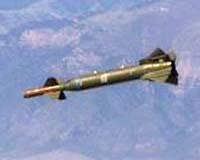Entered into the database on Saturday, July 16th, 2005 @ 18:32:54 MST
The United States is close to testing a new missile aimed at destroying deep bunkers
where suspected weapons of mass destruction are stored, the a British science
magazine has reported. Four prototypes of the new "bunker-buster" will be tested later this
year by Lockheed Martin Missiles and Fire Control of Dallas, Texas, which are
working with US Navy scientists on behalf of the Pentagon's Threat Reduction Agency,
it says. Traditional bunker bombs are streamlined bombs whose sheer weight enables them
to force through soil, rock or concrete before they detonate. The new design is different, the report, in next Saturday's issue of New Scientist,
says. The missile has a blunt nose that, combined with high velocity, creates a bubble
of air in front of the weapon. The idea is that the bubble forces earth out
to the sides as the missile descends, creating a cavity that the weapon can
slide through. The warhead could thus reach much deeper buried structures than conventional
bunker-busters, the inventors hope. The principle for the weapon comes from a new generation of high-speed torpedoes,
which create a gas bubble around themselves called a supercavity. A Russian torpedo of this kind, called Shkval, can move through the water at
360 kilometers (225 miles) per hour because it is essentially moving through
water vapour rather than water, and resistance is thus very low. "Lockheed Martin hopes the supercavitating missile will reach 10 times
the depth of the current air-force record holder, the huge BLU-113 bunker-buster,
which can break through seven metres of concrete (22.7 feet) or 30 metresfeet)
of earth," New Scientist says. In addition, the new weapon could carry more explosives than its predecessors. The BLU-133 needs a thick casing to resist friction, but a supercavitating
missiles could have a thin casing, leaving more space for explosives or incendiaries. The Pentagon wants an incendiary payload in order to incinerate chemical or
biological weapons, the report says
File photo of a bunker-busting missile. The missile has a blunt nose
that, combined with high velocity, creates a bubble of air in front of the weapon.
The idea is that the bubble forces earth out to the sides as the missile descends,
creating a cavity that the weapon can slide through.